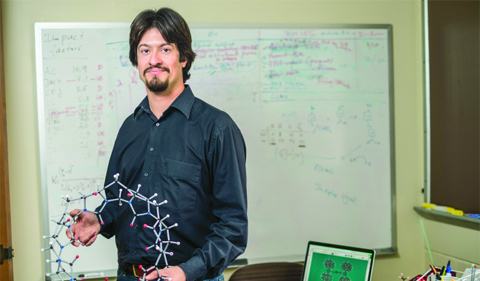The groups of Dr. Eric Masson and Dr. Oren Scherman, a collaborator from the University of Cambridge, UK, recently showed that Cucurbiturils, a family of molecules that have the shape of a hollow pumpkin, could be used as catalysts for a well-known reaction in organic chemistry.
By encapsulating reagents, Cucurbiturils force the reacting partners to sit close to one another, and ultimately trigger the desired reaction, an intramolecular Diels-Alder cycloaddition. Students who have gone through the CHEM 3050 and 3060 organic chemistry class series certainly have fond memories of this reaction!
Their study, “Cucurbit[7]uril as a Supramolecular Artificial Enzyme for Diels–Alder Reactions” was published in Angewandte Chemie, one of the preeminent academic journals in the field of chemistry. Masson, the Roenigk Chair and Associate Professor of Chemistry & Biochemistry at Ohio University, has been investigating Cucurbituril macrocycles for the past 10 years.
A key co-author on the study is one of Masson’s former graduate students, Dr. Xiaoyong Lu, who earned a Ph.D. in Chemistry from the College of Arts & Sciences at Ohio University in 2013. His LinkedIn states that he is a senior scientist with Sirnaomics Inc., a biopharmaceutical company in Maryland.
Abstract: The ability to mimic the activity of natural enzymes using supramolecular constructs (artificial enzymes) is a vibrant scientific research field. Herein, we demonstrate that cucurbit[7]uril (CB[7]) can catalyse Diels–Alder reactions for a number of substituted and unreactive N-allyl-2-furfurylamines under biomimetic conditions, without the need for protecting groups, yielding powerful synthons in previously unreported mild conditions. CB[7] rearranges the substrate in a highly reactive conformation and shields it from the aqueous environment, thereby mimicking the mode of action of a natural Diels–Alderase. These findings can be directly applied to the phenomenon of product inhibition observed in natural Diels–Alderase enzymes, and pave the way toward the development of novel, supramolecular-based green catalysts.





















Comments